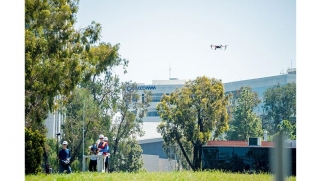AT&T and Qualcomm say they want to analyze how drones, also known as Unmanned Aircraft Systems (UAS), can operate safely and more securely on the commercial LTE networks of today and networks of the future, including 5G. Their trial, which will use AT&T’s commercially available spectrum, will evaluate network requirements in support of drone operations.
It’s not as if AT&T is on a fast track to start selling drones next to smartphones in its stores, however. “I don’t think that’s one of our primary goals,” said Matt Walsh, director of Business Development – UAS at AT&T IoT Solutions. “It’s always a possibility, I guess, but we’re focused on what are the services we can provide to the category.”
The use cases for drones are seemingly infinite. Companies like AT&T already use drones to inspect towers and to better understand network performance. Other companies are using drones to inspect power lines and pipe lines and roofs for insurance purposes. The use cases span a range of industries and capabilities, and AT&T wants to better understand not only how it can use drones internally but how drones can benefit from connectivity provided by AT&T. “Qualcomm is a great partner” and the ability to collaborate from a device and network standpoint is an exciting opportunity, Walsh said.

Qualcomm has been doing a lot of development for the drone/UAS category, looking at connectivity needs and use cases moving beyond line of sight, with cellular being a key enabler. This trial will allow Qualcomm and AT&T to look at the reliability and availability of LTE to support drone use cases and assess the impact there may be on the network, with the aim of looking at optimization for a particular user terminal, according to Paul Guckian, VP of engineering at Qualcomm.
Qualcomm is already playing in the space with a version of its Snapdragon chipset for drones. At CES 2016, the company demonstrated Snapdragon navigation software designed to provide the intelligence to perceive objects in flight paths for safer and more reliable navigation.
Interestingly, the location of the trial with AT&T in San Diego includes some instructive real-world conditions, including commercial buildings and residential areas. It’s only three miles from Marine Corp Air Station Miramar and military aircraft routinely fly over the company’s buildings, which is in restricted Class B airspace, so Qualcomm had to obtain all the proper certification and get authorization from federal regulators to perform the tests at its campus.
AT&T’s networks are configurable and optimized for ground users so part of the research will see if there is further optimization to be done to serve the drones. Simulations also will be used to see what happens when drones are deployed at scale -- meaning, what cumulative effects result when you try to deploy a lot of drones at the same time.
AT&T has been relatively public about its ambitions in the space. At the CES show in January, AT&T announced it was collaborating with Intel on drones.
“I think that we are striving to be the premier network provider in this category, and we want to be the premier service provider today and in the future,” Walsh said. The new partnership with Qualcomm positions AT&T to establish some learnings and prepare for what customers want now and in future use cases.
Related articles:
Qualcomm gets OK to test drones in Class B airspace at its San Diego campus
AT&T, Intel agree to test drones on LTE network
U.S. operators have big role to play in drones, says Small UAV Coalition leader

